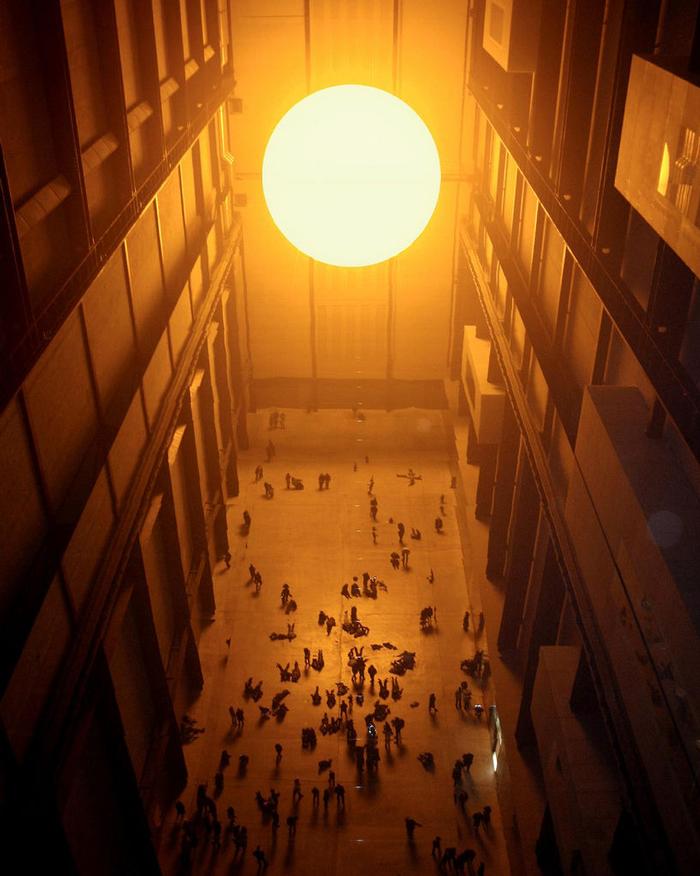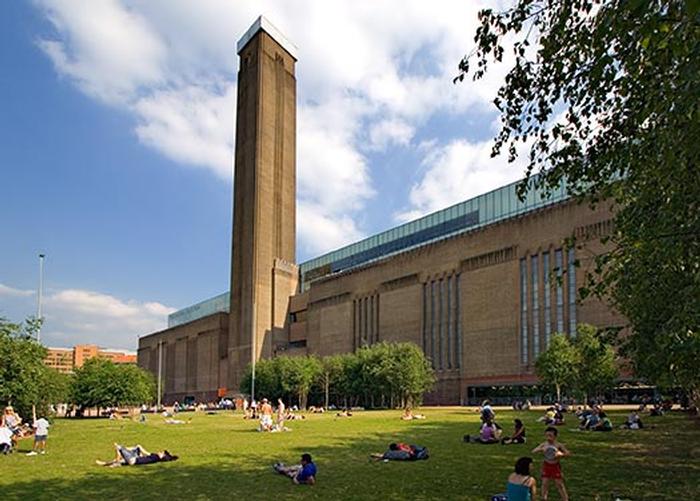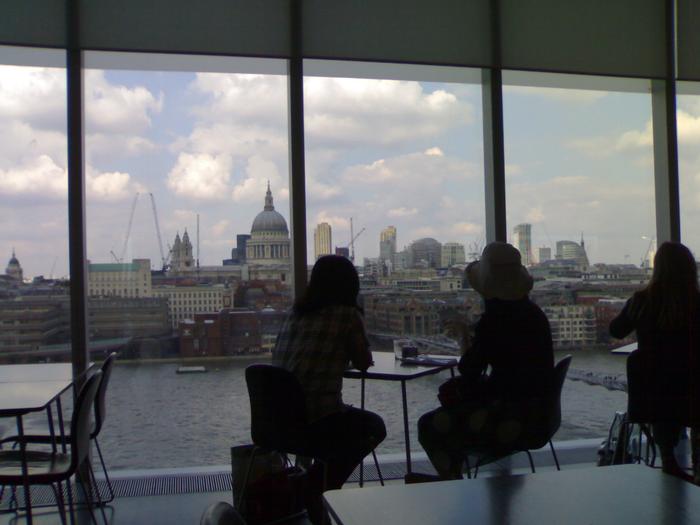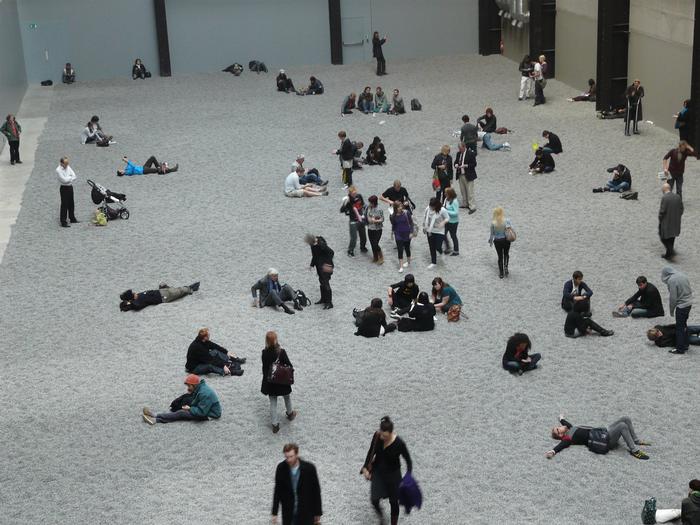[ID:491] Tate Modern, London's foremost contributor of the Public GoodUnited Kingdom December 2003. It’s my first time visiting London; so far it hasn’t lived up to my expectations. My feet hurt from the endless walking but resting is not an option as I am spurred on (read: ordered) by my mother to follow her into the Tate Modern. “Yet another museum,” I complain, trying to build a case for going shopping or stopping to eat somewhere. People with parents who are overly keen on visiting museums can relate to me instantly: my first time in London and all we do is visit museums and galleries – one after the other, day after day. My protests are to no avail, and when I reluctantly make my way down to the entrance, my mum is already inside. “I want to go home,” I think, following her into the Tate. The next moment, however, can only be described as surreal. All the negativity built up inside of me disappears like snow before the sun – literally, as I am staring into a giant artificial sun which illuminates me physically as well as mentally. It is ‘The Weather Project’ by Olafur Eliasson. That day the Tate Modern brought happiness to the life of at least one young man. There is, however, not a single doubt in my mind that it did the same for others too. On the basis of this experience, I will now argue that the Tate Modern should be considered the single largest contributor to the public good in London. First, I will take a look at what contributing to the public good means more precisely.
Broadly speaking, the term ‘public good’ denotes a mutually advantageous relationship between an individual and society. However, within this broad outline, the term ‘public good’ may have widely varying emphases. A utilitarian conception would focus on an ideal of ‘the greatest possible good for the greatest number of individuals’. This, however, assumes a ‘public good’ to be quantitatively different to an individual good, while remaining the same in essence. Such a view overlooks the role of society and an individual’s relationship to it. ‘Public good’ may also be understood as the sum total of conditions of a social life that allows an individual to freely shape their life in pursuit of virtue. This view of the public good is more helpful as it allows for the fact that the state and social institutions like the Tate Modern may be a vital component in the development of individual virtues.
To further specify the public good, I call upon the work of the great philosopher Aristotle. According to Aristotle, good in individuals could be understood as happiness, or ‘flourishing’. After disregarding the happiness provided by certain particular things, such as money, honour or pleasure, Aristotle concluded that authentic happiness could only be achieved by living a life characterised by rational activity. In Aristotle’s time, the political community, the city (or polis), was the highest form of community as it coordinated the actions and associations of the people within it. Aristotle reasoned that if mankind was a rational and political animal, then the ultimate aim of all human association should be the common good. Therefore the community and its institutions should serve all citizens, not just those of a particular social class, as individual happiness was distinctly associated with the health of society as a whole.
Aristotle’s ideas concerning the common good were expanded upon by Thomas Aquinas, who understood the common good in terms of particular ‘goods’. These could include material things such as food or money, abstract notions such as knowledge, and goods that were held for the possession of all, such as common land. Most significantly, however, Aquinas argued that a thing could be common to individuals by causality. Something that was numerically single could produce numerous effects. In our case that would be a singular art gallery (the Tate Modern) producing positive effects for its crowds of visitors.
In the twentieth century, some philosophers came to understand the common good in terms of social resources. Fair distribution of social resources for the benefit of the majority was seen as a function of the state. Karl Marx, generally considered as the father of communism, understood that as society advanced, the basic needs of food, clothing and shelter were surpassed by more complex needs like social participation and access to cultural commodities. The evolution of democracy over the past two centuries has reflected a changing emphasis on what may be understood to be a basic human need. The way that modern society has evolved has therefore involved a conception of the public good that depends upon society meeting the needs of the majority.
If, as Aristotle claims, mankind is essentially a rational, political animal, then institutions such as art galleries which foster critical reflection and rational activity are essential to the development of individual virtues, which are in turn essential to the health of society as a whole. Marxist thinking, which understands the public good in terms of the equitable distribution of social resources and access to cultural commodities, reflects an understanding that human needs grow more complex as society develops. Therefore, institutions such as the Tate Modern that provide (free and unrestricted) access to the arts for all people regardless of social class may be understood to be meeting a basic human need.
The relation between art and society is a complex one, but the importance of art galleries and access to the arts for the cultural health of a society is indisputable. The critical reflection that art encourages is very different from that inspired by written words. The use of different media means that art is often able to present many different viewpoints at the same time, without providing a single conclusion. More often than not, art raises questions instead of providing answers. Likewise art is often not explicit, but rather acts on an individual on a subliminal level, with elements of the work eliciting responses that may be emotional or spiritual rather than distinctly rational. We may like a work or hate it for reasons that we are not always able to formulate into words, and it is in art’s inherent rejection of linear narratives that it achieves its true power. Furthermore, in many ways, art may be seen as a criticism of the world as it is, presenting a commentary on society, or offering up alternative visions of the world. Michael Kimmelman, chief art critic for the New York Times, claims that the importance of art comes from the fact that it engages individuals on a very deep level, one which may not be shared by other members of a group. Going back to Aquinas then, it is possible for a single piece of art to not only have an effect on different people, but also to lead to different responses within each of these individuals. While it may be necessary to provide information regarding the works on display, it is also necessary that the exhibition leaves room for an individual to cultivate their own particular response to a work. The fundamental importance of participation between an individual and society that an art gallery encourages has been outlined by Peter Sellars, the director of the Los Angeles Festival, who claims that there can be no meaning in either art or society without participation.
This seems like a good moment to stake a special claim for the Tate Modern, which I’d argue is well ahead of its fellow modern art museums in this regard. Thanks to my mother, I have seen more than a fair share of museums, and I can safely say that when it comes to participation, the Tate Modern is simply unrivalled. The largest contribution comes from the Turbine Hall, where it is usually possible not only to see the art, but also to interact with it directly. Apart from ‘The Weather Project’, which is very special to me, another prime example of an exhibition that allows a high degree of participation is 2010’s ‘Sunflower Seeds’ in which the turbine hall was filled with millions of unique, handcrafted life-size marble sunflower seeds with which visitors could freely interact. When I visited this exhibition, I, like many others, were completely taken aback. For the second time I felt I had entered a space that transcended the limitations of an ordinary museum; a space interesting to all: young and old, male or female, all were engaged with exhibition. The sheer size of the Turbine Hall is important here; the two projects I described simply wouldn’t have been the same if displayed in a smaller space. Even when no exhibitions are being held, the Turbine Hall is important to the Tate: a space within the museum but at the same time outside of it, due to its different nature. It’s a space where people meet for a variety of reasons: having lunch, chatting, arguing, doing homework, kissing – I have seen it all. Echoing Peter Sellars’ arguments, I believe that it is precisely for this very high level of participation – a level unmatched in other museums – that out of all the modern art museums, I believe the Tate Modern to contribute most to the public good.
The Tate Modern is a space that is designed to allow individuals direct access to modern art in a way that preserves scope for individual responses and apprehension. It was first conceived when the Tate Britain in Millbank was struggling to house its growing art collection. The current iconic Tate Modern building was converted from a power station which had been built by the leading architect Sir Giles Gilbert Scott and subsequently closed in 1982. It was attractive to developers because of its striking appearance, as well as its location on the banks of the River Thames. The development of the Tate Modern had to combine the interests of various different groups of people, some of which may have been directly opposed to the scheme. The proprietors of the Tate collection needed to find a suitable place to store and display their growing collection. On the one hand, the building provided an extremely good space for current artists to mount new exhibitions, particularly in the massive Turbine Hall. On the other hand, there were the needs of the local community to consider. Southwark was a deprived inner-city borough, and while a huge investment like the Tate Modern could potentially bring in subsidiary business to the area, it was also important that the local community had access to the gallery itself. During the 1980s, Southwark Council had drawn up regeneration strategies to improve accessibility in the area. The redevelopment of the bankside power station was a principle feature of this, so when the Tate expressed an interest in re-developing the building for the purposes of displaying art, the arrangement was seen to be mutually advantageous. The London Borough of Southwark was a significant early investor in the project, alongside the Arts Council, who provided £6.2 million of lottery money, and English Partnerships (the government’s urban regeneration agency) which provided £12 million. The Tate Modern was also a Landmark Project for London by the Millennium Commission, which provided £50 million. All in all, the project cost £134 million.
Given the vast sums of public money invested in the building, it was important that the Tate Modern was understood to be for the public good, rather than just for one sector of society. This was particularly significant given its location in a deprived inner-city borough, as there was a danger of creating a strong contrast between the lavish display of ‘high’ culture in the gallery, and the deep-seated urban decay of its surroundings. Attempts to avoid this discrepancy may be seen not only in the various education and outreach programs that the Tate Modern runs, but also in its choice of design for the actual space. The choice to use a building that was already in existence rather than designing a new one from scratch was not simply a money-saving exercise. There is a historicity to the approach which recognises the area’s industrial past as well as the superlative design of the original building. The renovation of an originally utilitarian building for an entirely different purpose is both playful and practical. One of the reasons that the Swiss firm Herzog & De Meuron’s proposal for the development was accepted was because it retained much of the original character of the building, whereas other proposals suggested the removal of the iconic chimney. Besides the vast Turbine Hall, the building also makes innovative use of other areas. Above the original building’s roof is a two-storey glass penthouse which includes a café with amazing views of the river, as well as lower terraces offering wonderful views. Outside the building are birch trees and benches that suggest an austere but egalitarian community.
In conclusion, let me return to December 2003. “What would you like to do next?” my mum asked. For a brief moment I considered suggesting a spot of shopping, but sensing an uprising she quickly added “St Paul’s Cathedral or the Imperial War Museum?” I answered that I didn’t really care, to which she responded: “Good, St Paul’s it is then,” before commencing to cross the bridge over to the North Bank. Reluctantly following her, I realised that whatever came next was almost certainly going to be a disappointment. Nevertheless the Tate Modern had instilled in me a sense of hope that the next cultural attraction might – just might – be half as interesting, making the remainder of the trip a little more bearable and contributing to my personal good long after I had left the gallery.
It takes a more mature mind to realise that museums are not places where children are bored to death by their parents, that parents take their children there for a reason, and that people visiting museums out of free will are not insane. A deeper analysis like the one above shows that the Tate Modern is a triumph of egalitarian ideals in which ‘high’ culture does not belong solely to certain self-appointed guardians of cultural elitism. The innovative use of space within the building, the attractive gardens and public spaces in its vicinity, the manner in which works are displayed, as well as the effortless cool of its surroundings, all reflect an ideal world in which the arts are available to all, regardless of class. In such a world, an individual is not fundamentally at odds with their society but actively contributes to its health through critical reflection and cultivation of virtues, leading me to claim that in London, the Tate Modern, which has far transcended its role as an ordinary museum having taken on the additional role of social meeting ground, makes the biggest contribution to the public good.
Bibliography
Aquinas (2008) Selected Philosophical Writings (Oxford World’s Classics)
Aristotle (2000) Politics (Pearson)
Farthing S & R Cork (2010) Art: The Whole Story (Thames & Hudson)
Sullivan, S (2002) Marx for a Postcommunist Era: On Poverty, Corruption and Banality (Routledge)
www.tate.org.uk
If you would like to contact this author, please send a request to info@berkeleyprize.org. |




